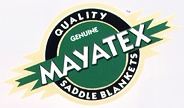|
CULTURED
COWBOY PRESENTS

Saddle
Blanket Care
for woven horse blankets,
whether used for horses or home decor.
USE AND CARE TIPS:
The importance of using quality saddle blankets is a "given"
among
knowledgeable horsemen. Today there are many good blankets and pads made of
different materials at varying costs, but the wool blanket is far and away still the
favorite of most professionals and recreationalists. As with anything worth using, a
good wool blanket is seldom "cheap" and should be considered an investment.
Why wool? For the equestrian, no other
material combines absorption, comfort, and durability like woven wool. While synthetics
only trap moisture between the fibers and cause undesirable heat build-up, wool absorbs
moisture away from your horse and releases heat build-up. Since moisture absorption
and release are gradual, wool is slow to feel damp and does not chill your horse by
too rapid drying. Wool breathes, is cool in the summer and warm in the winter.
Wool is an amazingly strong fiber composed of protein that grows with
a crimped wavy form, giving it excellent properties of elasticity and resilience.
This unique structure enables wool felt to conform to shape, which enhances the stability
between horse, tack, and rider. Form fitting wool felt prevents the shifting of your
pad while riding. Due to its natural elasticity, wool fiber has the ability to
retain shape, drape well, and is long wearing. The felting process increases the
shock absorbency of the wool fiber, providing soft cushion protection for both horse and
rider.
With proper care (requiring only a little attention), a wool blanket
will last for many years, even if used for many hours every day. Here are a few tips
to help you prolong the use of a wool blanket:
Beat and brush the blanket.
Every few days, simply
slap the blanket against a door, pipe fence, etc., then use a soft to medium stiff horse
brush (not a metal curry comb) and brush the hair and dander from the blanket. This
won't take more than five minutes of your time.
Wash the blanket.*
Every sixty to ninety days, wash
the blanket in a tub of cold water. For best results, put your blanket in a tub of
water and let it soak for at least an hour. Then, as best you can, "wring"
the blanket in the water then "wring" it out of the water. Now, hang the
blanket over a rail (like the top rail of a fence), and with a soft to medium brush,
lightly brush the blanket on both sides. Let the blanket air dry completely, then
slap it against a door or fence until it feels as soft as a brand new one.
*Note: It is best not to use soap
when washing wool blankets. The blanket will retain much of the soap (even soaps
made specifically for wool). When the blanket becomes wet with sweat, the residual
soap may seep through the very porous wool and irritate the horse's back. Still
- the need comes. I prefer Dawn dishwashing in the lightest color possible,
or Woolite (light or dark - match your colors).
After a few washings, the colors will, of course, begin to fade.
This has no bearing on the usefulness of the blanket in serving its true purpose.
You may place a new blanket on top if you are concerned with appearance, but you
will probably find that you prefer the older, faded, soft blanket next to your horse's
back. After all, the concept of saddle blankets is to protect your horse's back and
keep it comfortable. Happy riding!
Wear leathers? - Always recondition
leather after a cleaning. Lexol Conditioner is a favorite. Saddler's
One Step and other products are also good conditioners. Test Test Test in an
inconspicuous place before general use.
For your home decor: We
find that an occasional vacuuming will keep the blankets bright. Again,
shaking them or beating them will renew an fiber strands that have lain down.
Used as home decor, woven Indian blankets will keep their color for much
longer than those sweated often and rinsed often from the rigors of
riding.
HAND WOVEN SADDLE BLANKETS
Hand weaving is accomplished by interlacing the threads of the weft
and the warp on a loom.
The warp (nylon) is the thread that composes the
skeleton of the weaving and cannot be cut without the blanket unraveling. It is the
part that is manipulated by the loom with the use of a harness.
The weft (wool), on the other hand, composes the
body of the weaving and can be trimmed without the integrity of the weaving being
affected. In hand weaving, the weft thread is carried by a bobbin
that can hold enough thread to produce only a few inches of vertical length before
expending its supply of thread. This bobbin end must then be overlapped with another
bobbin end and the process of weaving can continue until the desired length is achieved.
Thick saddle blankets can have an many as 4-plys of yarn twisted
together to form one strand of yarn. When these bobbin ends pop up due to washing or
friction against the horse, the world may appear to be coming to an end!
However, these may either be trimmed off or tucked back under the warp thread.
Felted yarns (single-ply) generally produce less hysteria because there is only one strand
that will pop up. Felted yarns are generally thicker and more costly and are used
primarily for the more expensive custom woven saddle blankets.
To see the rest of the Mayatex Inc
Saddle blankets, Click your category below:
Arabian
Blankets | Custom
Show Blankets | Saddle Blankets
| Saddle
Blankets pg2 | Mayatex
Saddle Pads | Pony Blankets
| Saddle Blanket Care
or see other horse supplies at Cultured Cowboy
Horse Equipment Index Page
www.culturedcowboy.com
* Email or Call us to Order! 1-864-223-3700 or 1-866-492-6926 Toll Free * cowboy@culturedcowboy.com
|
